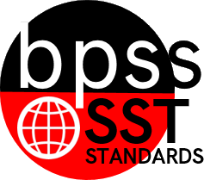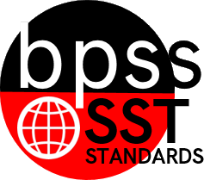3rd Grade Social Studies (Archived)
 BPS District Social Studies Standards Book
BPS District Social Studies Standards Book
SST-03 "I can ... statements"
1st Grade Social Studies
2nd Grade Social Studies
4th Grade Social Studies
5th Grade Social Studies
7th Grade Social Studies
8th Grade Social Studies
S |
|---|
SST-03.1.01
Student Learning Targets:Skills (Performance) Targets
Proficiency Rubric
ResourcesWebsites Helping Your Child With Social Studies
Vocabulary
| ||||||||||||||||||||||||||||||||||||||||
SST-03.1.02
SST-03.1.02 Create a mental map that demonstrates understanding of the relative location, direction, size and shape of the local community (e.g., school, hospital, post office, stores, landmarks, home).Student Learning Targets:Knowledge Targets
Reasoning Targets
Skills (Performance) Targets
Product Targets
Proficiency ScaleThe Student ...(1) Beginning
(2) Developing
(3) Proficient
(4) Advanced
Resources | |
SST-03.1.03
Student Learning Targets:Skills (Performance) Targets
Proficiency Rubric
ResourcesWebsites Helping Your Child With Social Studies
Vocabulary
| ||||||||||||||||||||||||||||||||||||||||
SST-03.1.04
Student Learning Targets:Knowledge Targets
Proficiency Rubric
ResourcesWebsites Helping Your Child With Social Studies
Vocabulary
| ||||||||||||||||||||||||||||||||||||||||
SST-03.1.05
SST-03.1.05 Construct time lines (i.e. periods in their own lives and the lives of their family members).Student Learning Targets:Knowledge Targets
Reasoning Targets
Skills (Performance) Targets
Product Targets
Proficiency ScaleThe Student ...(1) Beginning
(2) Developing
(3) Proficient
(4) Advanced
Resources | |
SST-03.1.06
SST-03.1.06 Interpret simple time lines (e.g., identify the time at which events occurred, the sequence in which events developed, and what else was occurring at the time).Student Learning Targets:Knowledge Targets
Reasoning Targets
Skills (Performance) Targets
Product Targets
Proficiency ScaleThe Student ...(1) Beginningis only able to answer basic questions about a timeline such as
(2) Developingis able to answer questions about a timeline by answer the following questions.
(3) Proficientis able to explain the meaning or interpret the information from the timeline by answering the following questions.
(4) Advanced
ResourcesVocabulary
| |
SST-03.1.07
SST-03.1.07 Use spatial terms to describe the world (i.e., equator, hemispheres).Student Learning Targets:Knowledge Targets
Reasoning Targets
Skills (Performance) Targets
Product Targets
Proficiency ScaleThe Student ...(1) Beginning
(2) Developing
(3) Proficient
(4) Advanced
Resources | |
SST-03.2
Narrative for the Important Historical EventsThrough active learning experiences, third grade students gain knowledge and process information about their local community from a variety of resources. Students describe how significant people, events and developments have shaped their own community and region; compare their community to other communities in the region in other times and places; and use a variety of resources to gather information about the past. Calculation Method for StandardsStandards are larger groups of related benchmarks. The Standard Grade is a calculation of all the related benchmarks. Click on the benchmark name below each Standard to access the learning targets and proficiency rubrics for each standard's related benchmarks. | |
SST-03.2.01
SST-03.2.01 Explain the importance of the accomplishments of scientists and inventors (e.g., light bulb, automobile, discovery of electricity, computer, telephone).Student Learning Targets:Knowledge Targets
Reasoning Targets
Skills (Performance) Targets
Product Targets
Proficiency ScaleThe Student ...(1) Beginning
(2) Developing
(3) Proficient
(4) Advanced
Resources | |
SST-03.2.02
Student Learning Targets:Knowledge Targets
Reasoning Targets
Proficiency Rubric
ResourcesWebsites Helping Your Child With Social Studies
Vocabulary
| ||||||||||||||||||||||||||||||||||||||||
SST-03.3
Narrative for the Economic ConceptsThrough active learning experiences, third grade students gain knowledge and process information about their local community from a variety of resources. They identify important historical events, places, and persons from the past and make connections with their present community. Students explain how people in the local community make choices about using goods, services and productive resources; how they engage in trade to satisfy their economic wants; how they use a variety of sources to gather. Calculation Method for StandardsStandards are larger groups of related benchmarks. The Standard Grade is a calculation of all the related benchmarks. Click on the benchmark name below each Standard to access the learning targets and proficiency rubrics for each standard's related benchmarks. | |
SST-03.3.01
Student Learning Targets:Reasoning Targets
Skills (Performance) Targets
Proficiency Rubric
ResourcesWebsites Helping Your Child With Social Studies
Vocabulary
| ||||||||||||||||||||||||||||||||||||||||
SST-03.3.02
SST-03.3.02 Explain how supply and demand affect personal economic choices (e.g., how scarcity forces people to decide which goods and services to obtain, what is given up in economic choices).Student Learning Targets:Knowledge Targets
Reasoning Targets
Skills (Performance) Targets
Product Targets
Proficiency ScaleThe Student ...(1) Beginning
(2) Developing
(3) Proficient
(4) Advanced
Resources | |
SST-03.3.03
SST-03.3.03 Explain the differences among natural and human resources, and how they are used locally.Student Learning Targets:Knowledge Targets
Reasoning Targets
Skills (Performance) Targets
Product Targets
Proficiency ScaleThe Student ...(1) Beginning
(2) Developing
(3) Proficient
(4) Advanced
Resources | |
SST-03.4
Narrative for the Government and CitizenshipThrough active learning experiences, third grade students gain knowledge and process information about their local community from a variety of resources. They identify important historical events, places, and persons from the past and make connections with their present community. Students explain what it means to be citizens of their community, state and nation; be able to identify the functions and major services provided by local governments; use a variety of resources to gather information about local, state and national governments; and demonstrate understanding of democratic principles and practices. Calculation Method for StandardsStandards are larger groups of related benchmarks. The Standard Grade is a calculation of all the related benchmarks. Click on the benchmark name below each Standard to access the learning targets and proficiency rubrics for each standard's related benchmarks. | |
SST-03.4.01
Student Learning Targets:Knowledge Targets
Proficiency Rubric
ResourcesWebsites Helping Your Child With Social Studies
Vocabulary
| ||||||||||||||||||||||||||||||||||||||||
SST-03.4.02
SST-03.4.02 Identify the three branches of local government (i.e., Executive, Legislative, Judicial).Student Learning Targets:Knowledge Targets
Reasoning Targets
Skills (Performance) Targets
Product Targets
Proficiency ScaleThe Student ...(1) Beginning
(2) Developing
(3) Proficient
(4) Advanced
Resources | |
SST-03.4.03
SST-03.4.03 Explain the rule-making process and its purpose in the school.Student Learning Targets:Knowledge Targets
Reasoning Targets
Skills (Performance) Targets
Product Targets
Proficiency ScaleThe Student ...(1) Beginning
(2) Developing
(3) Proficient
(4) Advanced
Resources | |
SST-03.5
Narrative for the Concepts of GeographyThrough active learning experiences, third grade students gain knowledge and process information about their local community from a variety of resources. They identify important historical events, places, and persons from the past and make connections with their present community. Third grade students explore their own community, including its geographic location. Students begin to understand other communities in the state and the world through simple comparative studies. Through group work and projects, students should increase communications and decision-making skills and build civic values relating to responsible community citizenship. Skills to receive special emphasis include: (1) using cardinal and intermediate directions and common map symbols; (2) locating their community, major land and water forms, and reference points on maps and globes. Calculation Method for StandardsStandards are larger groups of related benchmarks. The Standard Grade is a calculation of all the related benchmarks. Click on the benchmark name below each Standard to access the learning targets and proficiency rubrics for each standard's related benchmarks. | |
SST-03.5.01
SST-03.5.01 Identify the physical characteristics (e.g., landforms, bodies of water, vegetation, wildlife and climate) of the local community.Student Learning Targets:Knowledge Targets
Reasoning Targets
Skills (Performance) Targets
Product Targets
Proficiency ScaleThe Student ...(1) Beginning
(2) Developing
(3) Proficient
(4) Advanced
ResourcesVocabulary
| |
SST-03.5.02
SST-03.5.02 Identify the seven continents, four oceans, and major nations of the world (i.e. United States, Canada, Mexico; i.e. China, Brazil, Russia).Student Learning Targets:Knowledge Targets
Reasoning Targets
Skills (Performance) Targets
Product Targets
Proficiency ScaleThe Student ...(1) Beginning
(2) Developing
(3) Proficient
(4) Advanced
ResourcesVocabulary
| |
SST-03.5.03
SST-03.5.03 Describe ways (e.g., the development of transportation, communication, industry, and land use) geography has affected the development of the local community over time.Student Learning Targets:Knowledge Targets
Reasoning Targets
Skills (Performance) Targets
Product Targets
Proficiency ScaleThe Student ...(1) Beginning
(2) Developing
(3) Proficient
(4) Advanced
Resources | |
SST-03.6
Narrative for the Human Development and BehaviorThrough active learning experiences, third grade students gain knowledge and process information about their local community from a variety of resources. They identify important historical events, places, and persons from the past and make connections with their present community.Third grade students explore their own community, including its: human and material resources, major work and services, and basic beliefs and values. Calculation Method for StandardsStandards are larger groups of related benchmarks. The Standard Grade is a calculation of all the related benchmarks. Click on the benchmark name below each Standard to access the learning targets and proficiency rubrics for each standard's related benchmarks. | |
SST-03.6.01
SST-03.6.01 Identify the varying roles (e.g., parent, teacher, brother/sister, student, girl/boy scout, community volunteer) that individuals play in various groups (i.e., family, school, and communities).Student Learning Targets:Knowledge Targets
Reasoning Targets
Skills (Performance) Targets
Product Targets
Proficiency ScaleThe Student ...(1) Beginning
(2) Developing
(3) Proficient
(4) Advanced
Resources | |
SST-03.6.02
SST-03.6.02 Identify examples of how different groups, societies, and cultures are similar and different (e.g., in beliefs, traditions, family relationships, celebrations, institutions, folklore).Student Learning Targets:Knowledge Targets
Reasoning Targets
Skills (Performance) Targets
Product Targets
Proficiency ScaleThe Student ...(1) Beginning
(2) Developing
(3) Proficient
(4) Advanced
Resources | |


 Standard 1:
Standard 1: